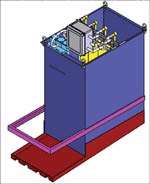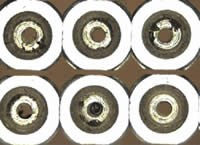Fine Tune Cleaning and Rinsing with Ultrasonic Retrofits
The same characteristics of ultrasonics that make them an important component on a new cleaning or pretreatment line also make them a valuable retrofit on an existing process line…
Ultrasonics can optimize the removal of some types of soils from certain parts, such as buffing compound from crevices and tiny particles from metalworking operations. Other excellent applications include precision cleaning of small objects and electronics assemblies prior to other finishing operations, and cleaning of valve bodies, transmission parts and sub-assemblies, medical devices and injection molds.
Sometimes ultrasonics will speed up a cleaning operation that would otherwise take much longer. For example, carbonization can be removed from injection molds in minutes instead of hours with the right combination of ultrasonics, heat, and cleaning solution.
Featured Content
In other cases, ultrasonics are used to meet the challenge of removing small particles from inaccessible areas, as a major manufacturer recently discovered when looking to reduce rejects on a research and development pretreatment line about to go into production.
Identifying the Cleaning Problem
The pretreatment line in question has been cleaning small screw machine type parts, about one-fourth inch in diameter, which will become part of gas assembly valves. The parts have a drilled orifice which traps both cutting oil and metal shavings. Because the parts are subsequently plated, cleanliness is critical.
The size and projected volume of the parts make racking impractical, so the parts are processed in both the pretreatment and plating operations in a motorized barrel loaded one-third full. Even with the mechanical action provided by the motorized barrel and a mild alkaline cleaning solution and multiple rinses, the cleaning was unsuccessful. A closer look at the process became necessary when O-rings farther along in the production chain failed to seat correctly on the parts, indicating the continued presence of oil and/or metal shavings.
In fact, microscopic evaluation of a sampling of 100 parts showed that 99 had some remaining soil contamination after barrel processing through the alkaline clean and multiple rinsing steps. So, although in theory, rotation would maximize part exposure to cleaning and rinsing agents, the combination wasn't getting the job done.
Process engineers explored various alternatives and/or enhancements for the process. These included different cleaning chemistries and electro-cleaning, but neither solved the problem.
How Ultrasonics Can Help
"Ultrasonics are a good option to consider in cleaning scenarios such as these, because of the nature of the cleaning activity they provide," says Ryne Johnson of Miraclean, who was called in to work on the project.
Ultrasonic energy occurs when sound waves are introduced into a liquid such as water. The sound waves create microscopic bubbles during periods of positive pressure, which implode and release a burst of energy during periods of negative pressure. This process is called cavitation, and in conjunction with appropriate chemistry and temperature, the energy undermines and releases soil barriers.
One of the most special aspects of ultrasonics is that the imploding bubbles travel wherever the solution goes, allowing cleaning activity even within complex part geometries. In this case, the rotating barrel holding the parts—with its small perforated openings for solution to flow through—had to be considered as well.
In a typical parts-cleaning application, ultrasonics are bottom-mounted and the watts of ultrasonics required are determined by the volume of the tank, the substrate and geometry of the parts, and the nature of the soil. Stainless steel process tanks are indicated, as they encourage reflection of the sound waves throughout the solution, thereby enhancing the ultrasonic action while at the same time withstanding it.
When cleaning with ultrasonics, the frequency of the sound waves is matched to the application. For the most part, lower frequencies (20-40 kHz) are safe for most applications and will produce the most intense cavitation energies to remove the most common types of contaminants (oil, grease, metal chips). They are also the most commonly used frequencies.
Higher frequencies (68-250 kHz) will produce smaller cavitation bubbles with less intense energies, but more of them. This can be beneficial in the removal of smaller particles and where damage is a concern (polished surfaces, delicate parts, soft substrates).
Accomplishing the Retrofit
The pretreatment line originally consisted of a series of polyethylene tanks, including a polyethylene cleaning station. Because space was available for a new clean station and polyethylene is not compatible with ultrasonics, Miraclean recommended adding a new stainless steel station to the beginning of the line where the ultrasonic cleaning activity would take place. (In other retrofit scenarios, ultrasonics can be added to existing stainless steel tanks.) Presented with the new tank option, process engineers decided to size the tank to accommodate two motorized barrels, thereby increasing throughput.
The new tank is equipped with 40 kHz of bottom-mounted ultrasonics, proven through testing to be able to penetrate the motorized barrel openings and cavitate throughout the load. The motorized barrel speed was minimized to promote the ultrasonic penetration and enhance the cleaning action. The tank also is equipped with heat, which encourages ultrasonic activity in a temperature range of 100 to 180ºF (above which heat reduces cavitation pressure and becomes counterproductive to ultrasonic activity).
Cleaning time in the new ultrasonic scenario remains the same as before: three minutes per load—now actually three minutes per two loads, thereby doubling production. As before, the cleaning station is followed by immersion in multiple rinses occurring in the original polyethylene tanks. The difference is that a recent microscopic evaluation of parts cleaned in rotating barrels in the new ultrasonic tank found that 99 out of 100 parts were clean and showed no evidence of cutting oil or metal shavings. Subsequent processes also now proceed without incident.
Ultrasonic Rinsing Takes a Turn
Ultrasonics are not always necessary in rinse tanks, but they can be recommended in certain applications where the geometry of the parts or the level of cleanliness required suggests that they would be of value (to meet a clean room or military specification, for example).
As with cleaning tank ultrasonics, rinse tank ultrasonics can also be retrofitted into existing applications to improve performance. One such application is a nickel chrome plating line at a major manufacturers, designed to plate a bright finish on parts.
The plating line consists of pretreatment, plate, and nine post-plating rinses, all heated and equipped with air spiders to promote solution movement. To eliminate unacceptable spotting, the last two rinse tanks are high quality DI water. The final rinse is followed by a recirculating hot air dry. Because the parts are now a finished product, they then move on to inspection and packaging.
Identifying the Problem
The problem that led to the ultrasonic retrofit in this case was a spot that mysteriously began appearing after the drying operation.
Orange to brown in color (indicating that it was errant hexavalent chromium plating solution), the spot was miniscule in size but very obvious on the otherwise bright finish. It occurred near a cavity, but was not visible during any of the nine rinses or until after the hot air dry, when it was discovered by product inspectors. A nuisance cosmetic imperfection, the spot then required hand-cleaning by the inspection team, which was time and energy consuming.
Evaluating Ultrasonics
The spot was traced back to imperfect rinsing despite the quantity of rinses, the air agitation and heat in the rinses and the DI water. Process engineers determined that the dry cycle was wicking the errant chrome out from the cavity.
Miraclean was called in to test ultrasonics in the rinse cycle. In a testimony to the power of imploding bubbles, 25 kHz ultrasonics tested as too powerful for the application, when the frequency microscopically opened a gateway in the cavity, affecting fit in the final part. The slightly less aggressive 40 kHz effectively removed the spot in testing without affecting part fit.
Retrofitting the Ultrasonics
There were two challenges to retrofitting ultrasonics on this production line. The first was that the nine rinse stations were all constructed of polypropylene, which while an economical choice in the world of multiple rinses, would not support ultrasonic activity. (Ultrasonic energy is absorbed by polypropylene, therefore losing some of the ultrasonic effectiveness, and ultrasonics will undermine the welds in a polypropylene tank causing tank failure.)
Miraclean designed a stainless steel tank insert for the third to the last rinse station on the line (the last tap water rinse). Sized to fit into the existing tank, the insert is outfitted with electric heat, a junction box for the heat and the ultrasonics, and a remote, cooled NEMA enclosure to house the ultrasonic generators and provide a central disconnect.
The second challenge on this retrofit was that the parts are rack mounted for plating on plastisol coated racks. Even here, the plastisol will absorb some of the ultrasonic energy, potentially minimizing its effectiveness. Plus the critical surfaces of the part face a side, not the bottom, of the tank in this application. Therefore, to maximize ultrasonic exposure to critical part surfaces, the immersible ultrasonic "cans" also are rack mounted and cover a side wall in this
application.
Rinse tank times remain the same as before the addition of ultrasonics (23 seconds of immersion per rinse). The result of adding ultrasonics to one rinse station in this process line is that the spotting problem that used to affect almost every part has been eliminated, thereby saving time and money.
Variety of Sizes and Configurations
Ultrasonics come in a variety of sizes and configurations. They are available as diaphragm-mounted in a dedicated stainless steel tank that has been sized to meet particular requirements, or as immersible stainless steel cans in a variety of sizes to be retrofitted into existing stainless steel tanks. As we've seen, they can even be retrofitted into polypropylene tanks by thinking outside the box (or inside the tank) and employing a stainless steel insert.
Ultrasonics in the right frequency for the job and at the appropriate watt density, can make a big and immediate impact on the success of a cleaning, pretreatment, or rinsing project. The potential for retrofitting ultrasonics means that you don't have to wait for a whole new process line to reap the rewards.





















